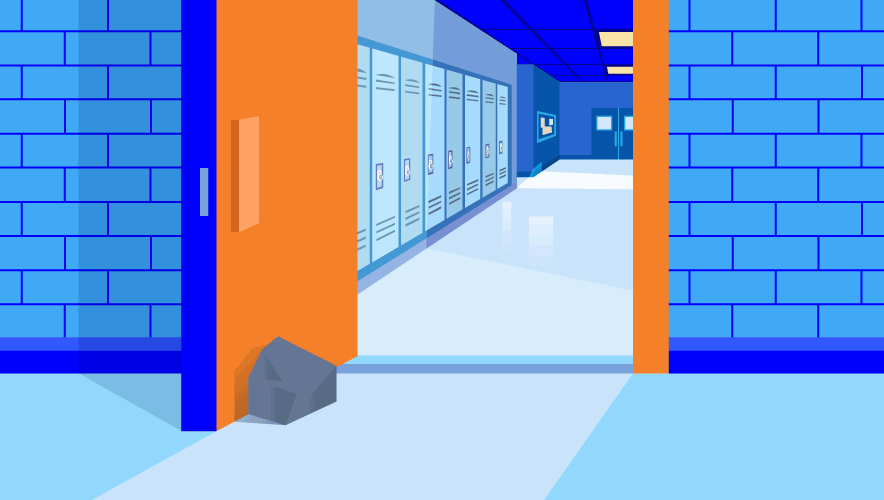3 Lessons for Building a Stronger School Security Culture
Recent high-profile incidents have focused intense scrutiny on safety and security in K-12 schools. Predictably, the result is intense pressure on school system officials to immediately improve their school security profiles. Add to this the appropriation of significant pots of dedicated money, and the results are predictable.
A one-time purchase and implementation of a technology-based solution is far too often seen as an easy way for school officials to be perceived as doing “something.” This can result in outcomes that are, in effect, little more than security theater. Repeatedly, we have seen that once such a solution is installed, everyone involved assumes that the school is now safe, and the job is done. Nothing could be further from the truth.
School security is an ongoing posture that a school community must adopt, not simply a set of processes or purchases. Like most efforts in education, school security is a process of continual improvement.
Technology-based systems for access control, visitor management, video surveillance, shot detection, mass communications, or weapons detection do not keep schools safe. Facilities elements such as doors, locks, laminated or ballistic glass, and window security film do not keep schools safe. Correspondingly, all of a school’s security policies, processes, and procedures—including anti-bullying programs, anonymous/confidential reporting systems, emergency operation plans, activate shooter response protocols, and behavioral threat assessment—do not keep schools safe.
Most school security failures are human failures and not system or equipment failures. It comes down to people. It is always the people of a school community who keep their school safe.
This is not meant to minimize the potential benefit and effectiveness of all of the equipment, policies, procedures, and processes listed above. I am a fan. I have advocated for most of them. But they are just tools, even the exceptionally good ones. And tools are used (or not used) by people. Absent a school security culture developed to be supportive of and committed to both a safe and secure educational environment and consistent use of these tools, continued school security failures are all but guaranteed.
To continue this discussion, a common understanding of the specific term “school security culture” is required. School culture and climate refers to a broad spectrum of human behaviors and interactions in the school environment.
Applied in this fashion, security culture is a school community’s shared security ethos: the culturally expected and accepted actions and normal daily practices related to school security that are common to the school community. By this definition, behavioral modification becomes the key to any improvement in school’s security posture. Acknowledging the “people keep schools safe” premises, a change in a school’s security culture becomes the foundational element for any meaningful, sustainable school security improvement.
Lesson 1: Where Security Stands Within Education
As you look to help schools begin the security improvement process, it is necessary to be aware of four major considerations. Two apply almost universally to most institutions, and two are unique to the K-12 educational environment.
The first consideration, common to most organizations, is institutional inertia: the pressure to continue to do things the way they have always been done. Change is always difficult for people, and change that requires increased effort is more so.
Second, most security practices and convenience are polar opposites. As applied to a school environment, remember that educators are already overtasked. Any process or procedure perceived to make a teacher’s mission more difficult will engender substantial opposition. The opposite side of the convenience/security coin in schools is the very real need to provide a safe and secure bastion for both students and staff where learning can occur. An effective school security posture must accept and balance the necessarily competing operational needs that exist in any healthy school environment.
The first of the school-specific considerations is simple. The primary mission of K-12 schools is education. Any process or procedure that adversely impacts effective educational practice will encounter significant resistance regardless of the potential security efficacy. It is critical to remember that our educators live with the educational imperative to create a warm, open, welcoming environment where students and parents feel not only free but encouraged to actively engage with learning. Decades of research by Robert Marzano and others have cemented this practice as an educational absolute.
Now add the final piece of the puzzle—the understanding that schools are operationally complex. Consider the context. Your local high school is a not only an instructional facility, but it is also a community center, a workout gym, a preforming arts theater, art studio, manufacturing plant, sports venue, chemical laboratory, warehouse, transportation hub, banquet hall, day care center, and several times a year a polling place. All this activity takes place every school day, from 6:00 a.m. to 11:00 p.m. Middle and elementary schools are equally integrated into the community. Complex may be an understatement.
Failure to consider these four factors will ensure that strategies and processes directly borrowed from other applications fit poorly. Too often these processes require staffing that is simply not available or more likely processes so intrusive of good educational practices that they are unsustainable. They can often be both. The predictable result is wasted money, empty effort, and abandoned or ignored initiatives, leaving schools less secure rather than more.
Lesson 2: Where School Security Fails
An examination of the cultural connections for some of the more commonly observed school security failures is likely to be instructive. One of the most common failures, noted over hundreds of school assessments, is a building perimeter exterior door propped open with everything from a rock to a trashcan or chair.
There is no rational argument that an unsecured exterior door does not present potential exposure. In fact, nearly all schools have a policy requiring a secure building perimeter and the accompanying procedures for the process. Millions of dollars have been expended on access control systems in the attempt to purchase a secure building exterior. Nevertheless, these systems often fail based on the difference between the externally imposed expected action and the culturally accepted action.
The imposed expectation is that all doors remain secure. The cultural expectation is somewhat different. The interplay of a secure educational environment with the need for a convenient educational environment can have both staff and students actively working against the externally imposed expected action. This can manifest in the cultural acceptance of doors left unsecure, doors propped open, or doors opened to allow individuals access without appropriate use of the visitor management procedure or display of a credential.
Speaking of credentials, another common cultural failure is staff and/or visitors not commonly displaying a visible badge. A photo credential prominently displayed by all staff members is much more than identification. It is the first step in creating the cultural expectation that all authorized adults on a school campus will be identified—a detection culture.
When you add a consistently implemented visitor management and badging protocol to consistent staff credentialing, the two work together to allow staff and students—at all grade levels—to help with the detection of unauthorized individuals on your campus. We teach our youngest students to recognize when one thing is not like the other, and with universal staff and visitor credentialing you can harness this skill to greatly enhance the detection of unauthorized visitors on campus. You will have created an important element of detection culture.
A master educational leader in a small Idaho school district was struggling with her staff consistently complying with the credentialing requirement. However, visitors were expected to display a visible credential. This caused some discord with the parents. This is not an unusual challenge in smaller and more rural school districts. After all, everyone knows everyone in a small town. Rather than fight the adults, this educational leader went to the student bodies in her three schools. She announced that any student reporting an uncredentialed adult in their school (this included the school staff) would receive a candy bar. The cultural shift toward both detection and compliance was nearly immediate and has remained in place over time. The enculturation of the process here is the key element of effectiveness and sustainability.
Effective behavioral threat assessment and management (BTAM) is the tool the U.S. Secret Service indicates is one of the most effective ways to prevent school violence. The process relies on the identification of and referral for review of students exhibiting concerning behaviors or deviation from their normal baseline behavior. When this process fails it is most often the failure to refer a student for review by the BTAM team.
School staff are particularly well positioned to observe and identify these concerning actions or changes in baseline behaviors. Cultural expectations will adversely affect the referral process. The first and maybe the most difficult for longer-tenured teachers is a cultural shift from “good teachers handle student behavioral concerns in their classrooms” to “good teachers identify and report behavioral shifts in their students.” This change must fight against significant institutional inertia. The second cultural failure is lack of belief in the system. Where there is no cultural expectation that the issue will be addressed and the student will be helped after a report is submitted, failure to report is infinitely more likely.
Like any other security practice, effective BTAM processes must engage the entire school community. For students it is a similar cultural shift that will allow the BTAM process to be most effective. The development of a “upstander” rather than “bystander” ethos is the critical first step. There needs to be an easily accessible, well-advertised anonymous or confidential reporting system. And just like for your teachers, a certainty that once reported the issue will be addressed. Reporting will only happen when students believe that a reported friend will be helped and not disciplined. There must be a cultural expectation developed across the school community that the school will cradle and care for students.
The key element in any human-caused school security failure is the externally imposed expectations and the lack of engaging the school community in the development of both the expectations and the accompanying processes. Without this step it becomes extremely difficult for operational expatiations to achieve cultural expectation status. This is key in the development of a cultural expectation. The first step in enculturation of practices common to the school community.
Lesson 3: Look Before You Leap
Effective planning always considers “assessment before treatment.” The first task is to identify the human failures that exist in a school’s current operational processes. Time and effort are also limited resources, and education must always remain the primary mission. Since no one can do everything at once, work to prioritize the identified vulnerabilities for remediation.
Newly identified vulnerabilities do not always require new solutions. Often, the broader education community has already identified highly effective practices. Known effective practices, consistently implemented by enculturation, are the best strategy to improve your school’s safety and security profile. New equipment and technology may help solve a specific problem, but it is consistent use of proven effective practice generally accepted and applied with fidelity that will be the key to a safer and more secure educational environment.
As the educator I still consider myself to be, I embrace the “assess before you treat” imperative. I encourage you to do the same. Examine a school’s climate and culture to contextualize the use, misuse, or failure to use the current physical and operational security elements available. This will help target the resources, time, and efforts that can truly improve any school’s safety and security profile by altering the school’s security culture. The outcome will be a safer and more secure school. And remember it is always the people of a school community that keep their school safe.
The school community’s enculturation of its school’s security processes will be the foundational element for the creation and maintenance of a safer and more secure educational environment for both students and staff.
Guy Bliesner is a founding member of the Idaho Office of School Safety and Security, and he serves as a school safety and security analyst assigned to schools in southeast Idaho.











